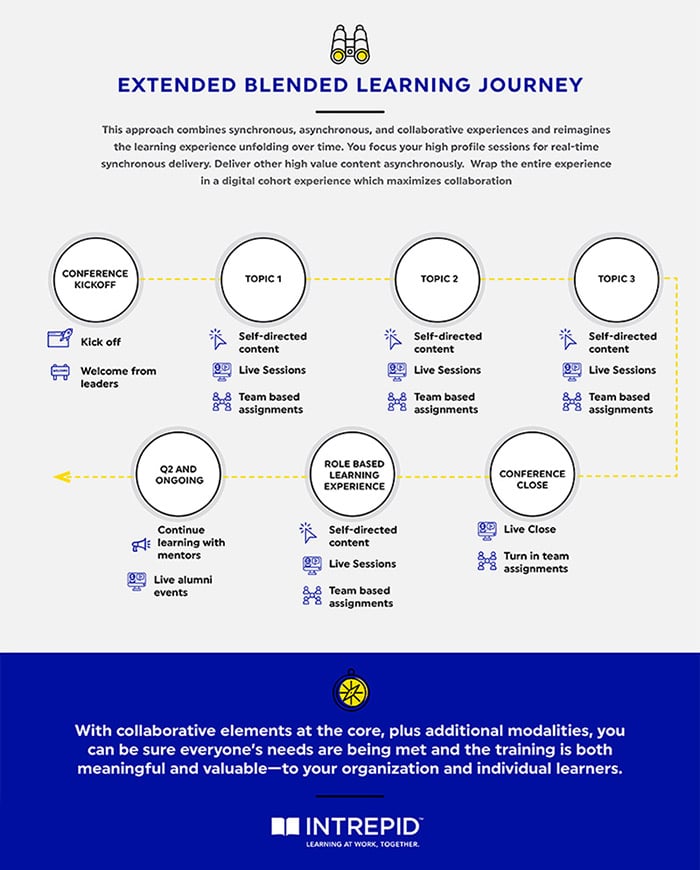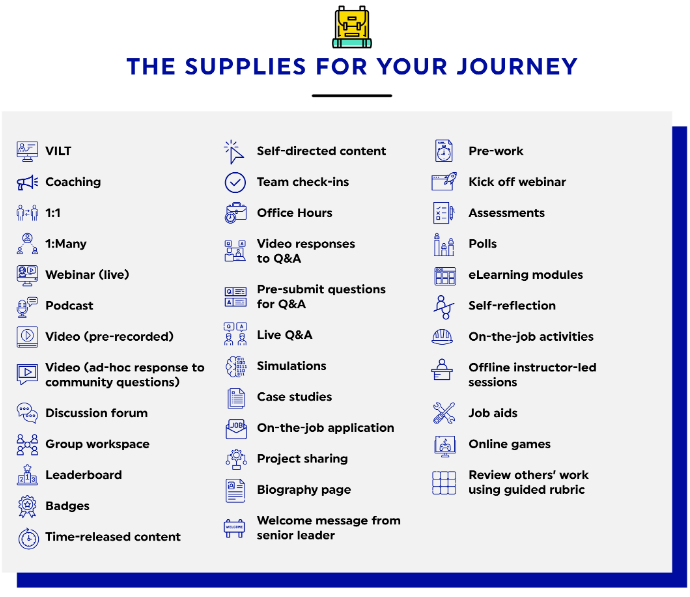Blended learning has established itself as a cornerstone of modern L&D strategies, serving as the secret ingredient to training success. Traditional blended learning is asynchronous online learning and traditional in-person learning, a method that changed how businesses train their employees.
But the traditional blended learning approach is a bit different than what it is now. So what is blended learning today and why is it such an intelligent training approach? Let's take a closer look at the modernized approach and its key features and benefits.
What does today's blended learning model look like?
An innovative approach to corporate training, today's digital blended learning model is a combination of synchronous, asynchronous, and collaborative experiences to reimagine the learning experience within a defined timeframe. This semi-synchronous hybrid creates a captivating and inclusive learning environment, appealing to various learning styles and speeds.
Traditional blended learning wasn't necessarily interconnected, but more so an either/or experience. Now, it's either/and--with a focus on blending various components and modalities together to allow learners to engage with content differently and maximize the learner experience.
Digital blended learning is facilitated by technology while giving learners control over time, place, path, and pace. This provides the flexibility for employees to learn on their own time (on demand), but also while learning at scheduled times with an instructor—whether that be in person or virtual. The experience paves the way for learners to be engaged on a deeper level, which is further maximized by blending in peer-to-peer learning and collaboration.

As mentioned, at the core of this approach, we find two distinct but complementary paths: synchronous vs asynchronous learning.
Asynchronous vs synchronous learning
"Synchronous" means everyone's learning together, simultaneously. An example would be live interactions, whether they're happening in the same room or bridging distances online. This learning method allows for direct connection with your instructor and peers, echoing the familiarity of a traditional classroom setting.
Asynchronous learning, meanwhile, offers the liberty to explore learning materials at a convenient pace, breaking free from the constraints of a set timetable. This kind of freedom really lets learners take charge, helping them grasp and remember more, as they can move through the learning process at their own pace.
Why has the digital blended training approach become so popular in recent years?
As the COVID-19 pandemic hit, blended learning took off in workplaces. Out of nowhere, remote work became the norm, and e-learning shot to the forefront as the answer. Amidst all this, blended learning emerged as a strong, flexible option, ready to tackle the surprises thrown our way at the time.
A quick look at the Global eLearning Services Market Report shows that in 2022, blended learning services had the highest revenue share at 35.3%, surpassing mobile learning, virtual classrooms, and simulation services. And there is good reason for these market trends. Blended learning offers a unique combination of flexibility, personalization, and interaction that caters to the diverse needs and preferences of modern learners in these post-pandemic times:
- Flexibility: The rise of remote work requires adaptable learning through the blend of online and in-person formats.
- Personalized Learning: Modern learners seek customized experiences with flexible pace and content.
- Continuous Learning: Blended learning meets the growing demand for ongoing professional development through various formats.
- Collaboration: Online networks support peer interaction, an essential aspect of blended learning environments. Explore our whitepaper on collaborative online learning for actionable insights.
Blended learning continues to show its value by providing flexible learning solutions to a wide range of people with varying needs and schedules.
Unlocking engagement: The AGES Model for blended learning design
Designing a blended learning program involves choosing the right models and methodologies. The AGES Model, based on research from the NeuroLeadership Institute, offers a powerful framework. AGES focuses on four key components to maximize engagement:
- Attention: Grabbing and holding a learner's attention is crucial. Blended learning allows you to use a variety of engaging formats to keep them interested.
- Generation: Moving from passive to active learning is essential. The AGES Model encourages activities that prompt learners to think critically, reflect on what they've learned, and generate insights they can apply to their work.
- Emotional Connection: Understanding the "why" matters. Help learners connect with the material by highlighting its relevance to their roles and goals. This sparks excitement and fosters a more meaningful learning experience.
- Spacing: Cramming information doesn't work. Spaced learning, a core principle of the AGES Model, ensures knowledge retention by distributing learning activities over time.
By incorporating these elements, the AGES Model helps you create blended learning programs that are not only informative but also highly engaging.
Digital blended learning example
The variation in blended learning models is a manifestation of the versatility of this approach. Organizations will have a different blend of modalities depending on their learning objectives, resources, and the nature of their learner populations.
Here is one example of what a digitally blended experience can look like over time.

What are the benefits of blended learning in corporate training?
There are numerous blended learning benefits for corporate training, making it a popular choice among organizations. Some big pluses are:
Cost reduction
Every dollar spent on training is an investment in organizational growth and employee development. With blended learning, companies are witnessing a remarkable shift in how their money is used to nurture talent. Cost savings emerge through a reduction in travel, lodging, and traditional venue expenses, thanks to the integration of online learning resources – an astute move towards a better return on investment.
Customization and personalization
Gone are the days of the one-size-fits-all method. Online modules can assess individual needs and suggest targeted resources, while the flexibility of blended programs lets learners choose their learning format. Whether it's diving deep into online visuals or engaging in hands-on workshops, this customization ensures a personalized learning journey that caters to each employee's strengths and preferences.
Learner engagement
Blended learning isn't just about delivering content, it's about igniting a fire in the learner. By combining online and in-person elements, blended programs offer a dynamic learning experience.
Online modules can optimize learner engagement with interactive elements, gamification, and bite-sized learning bursts. Instructor-led sessions then provide opportunities for collaboration, application of knowledge, and discussion that fuels deeper understanding. This variety keeps learners engaged, fosters active participation, and ultimately leads to a more enriching and memorable learning experience.
Better talent retention
Employee retention is no small matter in the corporate world. When companies provide training that employees find productive and career-boosting, they're more likely to grow roots in the organization. Now more than ever, employees seek more than just a paycheck; they yearn for a purpose and a clear path for career progression. Blended learning speaks to that need by offering versatile, growth-oriented learning opportunities.
Improved learner data
Blended learning provides a treasure trove of data for administrators and instructional designers. Online components often track learner activity, progress, and assessment results in real-time. This offers valuable data-driven insights into learner engagement, knowledge gaps, and areas where the program excels.
Administrators can use this information to measure program effectiveness and make data-driven decisions about future training initiatives. Similarly, designers can leverage this data to refine content, personalize learning paths, and ultimately, optimize the blended learning experience for maximum impact.
Best practices for an effective blended learning approach
Crafting a blended learning program that meets the needs of both the organization and its employees requires thoughtful planning and execution. It should not be about simply repurposing content from one setting to another but rather about designing a holistic educational experience that leverages the unique strengths of each element.
Intrepid's approach to blended learning embodies this evolution by seamlessly integrating synchronous and asynchronous learning with collaborative experiences that redefine professional development over time.
These best practices form the backbone of our blended learning strategy, ensuring every program we design surpasses the benchmarks of effective professional development:
Timebound blended learning
Imagine a course that unfolds like a story, where each chapter builds on the last. Time-released content does just that, providing learners with a structured progression through the material. There are many ways to do this, but here are a few recommended examples:
- Virtual Instructor-Led Training (VILT): Live sessions to kickstart learning chapters
- One-on-One Coaching: Personalized feedback moments
- Webinars: Group discussions for broader understanding
- Pre-recorded Videos: On-demand insights accessible anytime
- e-Learning Modules: Self-paced learning segments for deep dives into topics
Collaborative learning opportunities
A collaborative learning environment makes learning stick. With technologies at our fingertips, participants engage, contributing diverse viewpoints and knowledge. This includes:
- Discussion Forums: Where learners exchange insights and learn from collective wisdom
- Group Workspaces: Dedicated areas for teamwork and project development
- Team Check-Ins: Regular sync-up sessions to stay aligned and accountable
Focus on practical application
Application cements theory into practice. To this end, a significant proportion of our strategy calls for learners to test and apply their newfound knowledge in real-world scenarios. Here’s what this looks like in practice:
- Active Learning: Via on-the-job tasks and engagements
- Job Aids: Handy resources to apply learning points day-to-day
- Simulations: Safe environments to practice and perfect skills
Built-in motivation and progress tracking
Keeping learners motivated is part of the equation for successful outcomes. We deliver this through:
- Digital Badges: Visual tokens of achievement
- Gamification: Engaging, competitive elements for fun learning
- Quizzes: Checkpoints to assess and reaffirm knowledge gained
Conceiving an impactful blended learning program isn't a simple task. It's a finely crafted strategy, much like curating an exhibition for maximum effect. With these best practices as part of your L&D palette, you're better equipped to paint a picture of success for your learners.
The future of training: How blended learning software drives results
Blended learning is already powerful on its own, but the right blended learning software can really kick things up a notch, making the learning experience super engaging and efficient.
A major health provider faced high nurse manager turnover and needed to develop their leadership skills for better patient care and talent retention. Traditional training methods weren't ideal due to time constraints. Their solution? A blended training solution using Intrepid.
The pilot consisted of a five-month learning journey that wrapped an online experience around four in-person sessions, allowing for flexible learning and real-world application. The four in-person events included online content, peer discussions, and Missions that applied learning to the real job. Smaller peer groups were formed at the in-person events to foster networking, and also continued with online discussion forums where learners could learn from each other’s experiences.
Nurse managers reported high satisfaction with the program, particularly its relevance to their daily work. They also showed significant improvement in leadership skills and knowledge, leading to a more engaged and empowered workforce.
Blended learning tools for your journey
Now that you've seen the power of blended learning software, here's an example of the modalities you might use in your digital blended learning approach. You can leverage a diverse combination of blended learning tools to build a customized and engaging learning journey that suits the needs of your corporate training programs.

Want to learn more about the best practices for creating an effective digital blend? Listen to this interactive session on blended learning best practices, where we share valuable insights from client experiences and proven strategies for building empowering and engaging online learning environments.
Frequently asked questions about blended learning
What is blended learning?
Today's digital blended learning model is a combination of synchronous, asynchronous, and collaborative experiences to reimagine the learning experience within a defined timeframe.
What are the benefits of blended learning?
There are numerous blended learning benefits for corporate training, including:
- Cost reduction
- Customization and personalization
- Increased learner engagement and motivation
- Better knowledge and talent retention
- Improved flexibility and scalability
What is an example of a blended learning program?
A blended learning program could include online modules for flexibility, combined with virtual or in-person sessions for real-world application, networking, and ongoing peer discussion.
false LOREM IPSUM TITLE




 Previous
Previous